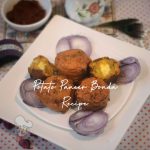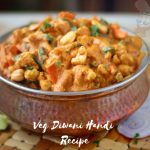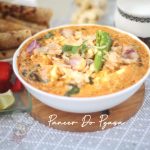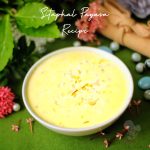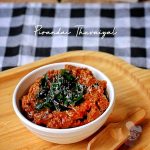Cook this authentic Handi Paneer in your new earthern handi with unique condiments and have a heavenly culinary experience...
An Introduction On Handi Paneer:
Handi Paneer is an exemplary punjabi delicacy, which has been considered as a royal and fantabulous dish since several centuries and from punjab it slowly spread to other parts of the country. Now it is popular all across the globe and chosen for special occasions and parties as it is versatile and delicious as well. Being indispensable in any North Indian festive thali, this Handi paneer spruces up any main course menu with its sleeky texture and enchanting flavor. It goes well with parathas, naans, kulchas, plain rotis and phulkas and also rice varieties like plain rice, mixed rice varieties, dum briyanis and pilafs. It captivates everyone's attention as a spectacular curry which could elevate your dinner platter to the next level.
With spongy paneer as its key ingredient, this handi paneer is made with the addition of other simple yet crucial components like hung curd, ginger garlic paste and tomato puree which give the desired spiciness and tanginess to the dish. Seasoned with an array of regular Indian aromatic spices, this handi paneer is spruced up with creamy onion cashew paste which makes the curry all the more rich. And finally it is presented with the embellishments like fresh cream, coriander leaves, lemon wedges and fried green chilies that would enhance the whole flavor and allure you at the very sight of it.
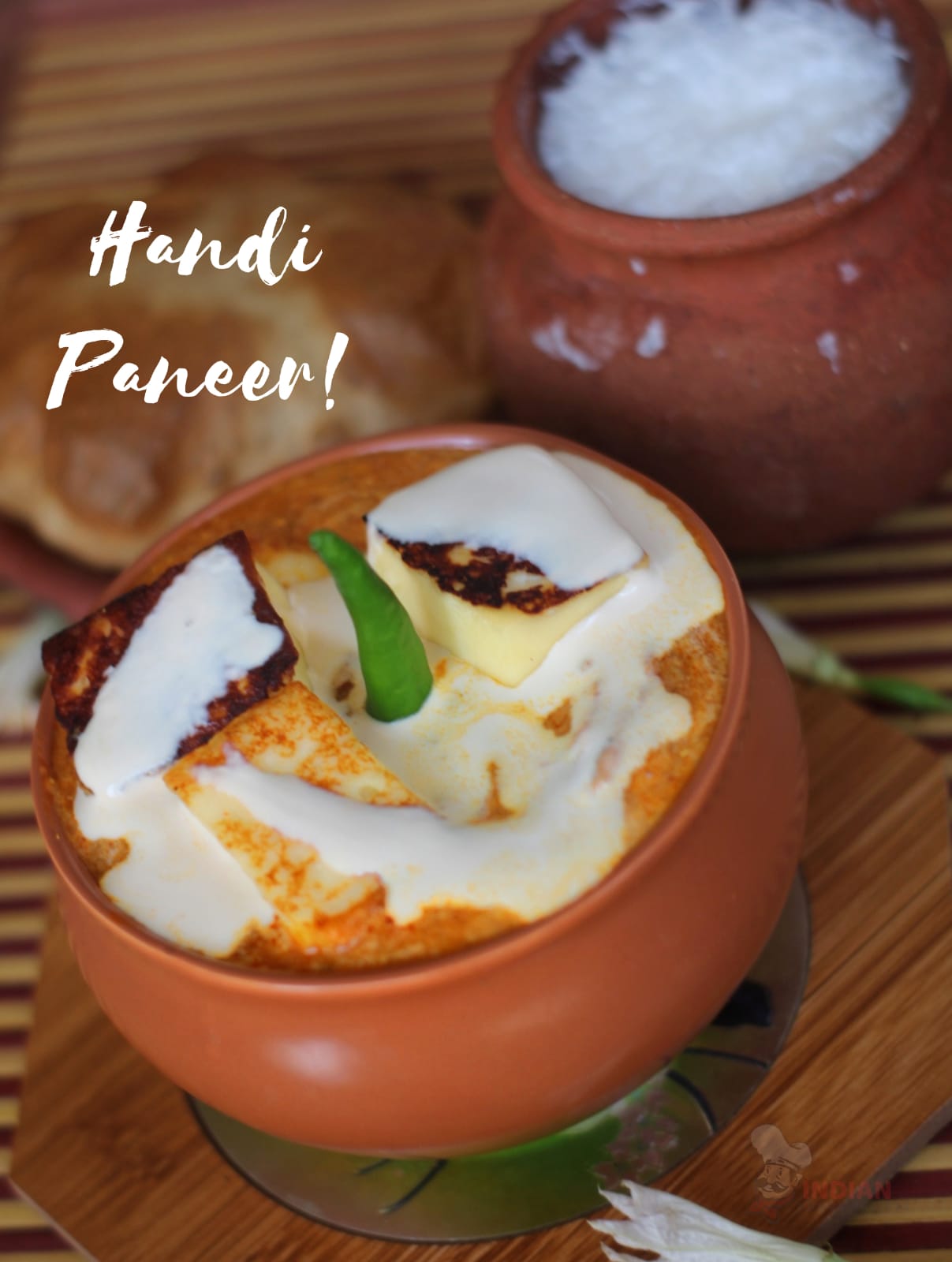
Ingredients Required To Make Handi Paneer Recipe :
How To Make Handi Paneer Recipe :
Tip in a clove, an anise and an inch of cinnamon in a small mortar and pestle and pound nicely to make a coarse powder out of it and keep aside.
Heat a small handi and tip in a little oil and when it is heated add a diced onion and roast it till golden brown. Turn off the flame and when it cools down, add it to a blender along with some cashews and blitz for two or three pulses to make a smooth paste out of it. In the same handi, sprinkle a little more oil and fry the paneer too until golden brown. Keep both the things aside.
Heat the handi again and set the flame in medium high mode. Add two or three tablespoons of butter and when it starts to melt down, tip in two teaspoons of mustard oil and drop in the aromatic spices one by one. First throw in the bay leaf followed by mace, clove, peppercorns and cumin seeds. At last, add the black and green cardamom and when it turns aromatic, just lower the flame and start the main procedure.
Squirt in a teaspoon of ginger garlic paste and after a few seconds, add the dry masala powder and wait for it to become fragrant, and now plop in the tomato puree and stir in for a while. Just wait for a minute or two till the distinct raw smell of tomato goes off and now gently add the masala paste and keep stirring for a while. Let the flame continue to be in low mode so that each and every step is done meticulously under slow cooking.
Wait for a while for the mixture to get blended, and when the oil starts to separate at the sides, start adding the spice powders. First tip in a teaspoon of red chili powder and then add the coriander powder. Similarly, add the turmeric and cumin powders with a nice stir. Let it blend for a while and wait for the whole mixture to savor. At this stage, spurt in a cup of hung curd and keep stirring for a few seconds continuously. Add a little water to half a cup of wheat flour and make a thick dough. Roll the wheat dough into a thick mould and seal the handi gently with the dough as a lid and let it boil in low flame for some time.
Just after a few minutes, take the dough seal off and tip in half a teaspoon of garam masala and finally spill some crushed kasuri methi. Combine altogether and wait for the oil to separate at the sides. When the whole mixture turns aromatic, just plop in two to three tablespoons of fresh cream and garnish with some lush green coriander leaves. Now the delicious Handi Paneer is ready. Serve it hot for aloo paratha along with a cup of chilled chaas.
Topics Included:
* An Introduction of Handi Paneer:
* Little and Interesting facts of a) Handi
b) Dough Seal
c) Black cardamom
d) Mustard Oil
*Ingredients to make Handi Paneer
* Directions
* Nutritional Value
* Tips
* Excerpt
An Insight Into The Special Ingredients & Items Of Handi Paneer:
Handi: - An authentic cooking pot which originated from India, usually made of clay or copper, has traversed a long journey in the Indian gastronomy. This Handi has been used since several centuries especially for slow cooking and was more famous during the mughal rule in India, though it existed way before that era like the Indus valley civilization. Excavations from Harappa and Mohanjadaro still have reminiscences of clay pots being used there for decades. There are two major benefits of slow cooking in Handi. Firstly, it retains the nutrients to the fullest as it uses only the moisture present inside the dish and secondly it gives an authentic flavor to the dish.
Dough Seal:
In ancient India, dough seal was much prominent to make meat based dishes and was quite popular during the mughlai period where rice, vegetables, meat and spices were all put together in a giant handi and left for hours or even overnight for slow cooking with a thick and enormous dough seal. It was basically invented for soldiers and the public which ultimately turned out to be the nawabs' favorite food over a period of time and this is how it became the noteworthy dish of the royal kitchen in the 18th century. Generally, all purpose flour is used for making the dough and it is usually thick and firm. Its purpose is to retain the flavors, nutrients and the essence of all the ingredients intact by slow cooking.
Black Cardamom:
It is one of the boon spice which originated from the Indian subcontinent and one of the precious ingredient used in ancient India not only for cooking but also in Ayurveda and Unani for its exceptional therapeutic properties. Being much adored as the culinary condiment in the Indian cuisine, it has been predominantly used in delicacies, curries, stews, gravies and pilafs. This black cardamom is one of the expensive spices that has been exported from India to other countries. Much interestingly, research says that more than fifty percent of the world's produce of black cardamom is from India. The difference between green cardamom and black cardamom is that the former has and mild and subtle flavor whereas the latter has a distinct and prominent taste.
Mustard Oil:
It is one of the irreplaceable ingredient in the Indian Cuisine since ages and it has been widely used in the Northern and the eastern part of the country. Its unique pungent flavor spruces up any dish to the next level and once we get acclimatized to its distinct taste we would fall for it even before we could realize. There are umpteen number of traditional dishes that are cooked with this mustard oil and one such remarkable dish is this Handi Paneer. Besides, this amazing oil comes with a host of health benefits which our ancestors were well aware of. Apart from being nutritious, mustard oil acts as a great beautifying agent as it promotes hair growth and skin tone. In the North, grannies and moms have the habit of doing body massage to new born babies with warm mustard oil and give sun bath to capture vitamin D, and this ritual is followed with such fervor and fondness and there are trained nannies to do that. This has been in practice since several decades and we are fortunate enough to have the lineage of a healthy well being and we owe it all to our parents and grandparents. It is up to our discretion to make use of these miracle ingredients in our day today cooking, which have been consumed by our ancestors with fondness and diligence since several decades.
Here is the recipe of Handi Paneer made of some distinguished components from the primeval Kitchen Of Ancient India:
Some Points To Be Noted:
* You can use both home made and store bought paneer to make handi paneer. You can chop in any size or shape as per your choice.In some versions, it is diced into cubes and in some other versions its diagonally chopped in diamond shape. And in yet other versions it is cut into square or rectangle shapes with varied thickness.
* Earthern handi is the best choice to make authentic handi paneer and you can also use handi made of any other metal like brass or bronze. Even stainless steel handi with copper bottom can also be used. Just see to it that the bottom is heavy and sturdy.
* If you cook in the new clay pot season it continuously for three days with rice water and nowadays seasoned clay pots are available at the market and go for one.
* Traditionally mustard oil has been used to make handi paneer as it has enormous health benefits and also adds more flavor. But if you do not like the mildly pungent taste of mustard oil you can add any other cooking oil which you use regularly.
* If you have slibatta at home its well and good to crush the dry spices as it is the traditional method to do so and undeniably it gives an authentic feel.
Ingredients
Directions
Tip in a clove, an anise and an inch of cinnamon in a small mortar and pestle and pound nicely to make a coarse powder out of it and keep aside.
Heat a small handi and tip in a little oil and when it is heated add a diced onion and roast it till golden brown. Turn off the flame and when it cools down, add it to a blender along with some cashews and blitz for two or three pulses to make a smooth paste out of it. In the same handi, sprinkle a little more oil and fry the paneer too until golden brown. Keep both the things aside.
Heat the handi again and set the flame in medium high mode. Add two or three tablespoons of butter and when it starts to melt down, tip in two teaspoons of mustard oil and drop in the aromatic spices one by one. First throw in the bay leaf followed by mace, clove, peppercorns and cumin seeds. At last, add the black and green cardamom and when it turns aromatic, just lower the flame and start the main procedure.
Squirt in a teaspoon of ginger garlic paste and after a few seconds, add the dry masala powder and wait for it to become fragrant, and now plop in the tomato puree and stir in for a while. Just wait for a minute or two till the distinct raw smell of tomato goes off and now gently add the masala paste and keep stirring for a while. Let the flame continue to be in low mode so that each and every step is done meticulously under slow cooking.
Wait for a while for the mixture to get blended, and when the oil starts to separate at the sides, start adding the spice powders. First tip in a teaspoon of red chili powder and then add the coriander powder. Similarly, add the turmeric and cumin powders with a nice stir. Let it blend for a while and wait for the whole mixture to savor. At this stage, spurt in a cup of hung curd and keep stirring for a few seconds continuously. Add a little water to half a cup of wheat flour and make a thick dough. Roll the wheat dough into a thick mould and seal the handi gently with the dough as a lid and let it boil in low flame for some time.
Just after a few minutes, take the dough seal off and tip in half a teaspoon of garam masala and finally spill some crushed kasuri methi. Combine altogether and wait for the oil to separate at the sides. When the whole mixture turns aromatic, just plop in two to three tablespoons of fresh cream and garnish with some lush green coriander leaves. Now the delicious Handi Paneer is ready. Serve it hot for aloo paratha along with a cup of chilled chaas.


